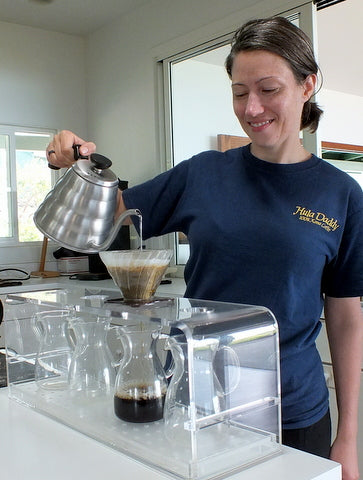How to Brew Kona Coffee Using a Pour Over Filter by Karen Paterson
Manual pour over coffee brewing is the “new rage.” Gourmet coffee shops all over the USA and Canada have converted to “slow bars” where every cup of coffee is individually brewed. This gives the customer the ability to pick the beans they want brewed instead of having to take whatever is in the airpot. The trade off is that instead of a $1.50 cup of coffee, each cup now costs $5.00 and up.
We make pour over cups at Hula Daddy when customers want to taste a coffee. Our tour leaders have become outstanding at brewing pour over cups.
There is nothing new about manual pour over coffee. In some countries, coffee has been brewed using a pour over method for hundreds of years. In the 1960’s, two popular pour over brewers in the USA were Melita and Chemex. However, today there is a difference. The equipment is the same but the brewing method is different. Instead of filling the filter to the top with water to push it through the grounds as fast as possible, water is pulsed into the filter to extend the extraction time. The difference is amazing.
The big commercial coffee companies have caught on to the difference. Bunn, Curtis and Fetco are now offering automatic commercial machines that extend the brewing time and improve the flavor. Automatic pulse brewers on also coming on the market for home use e.g Behmor and Bunn.
In spite of what you see in the coffee shops, you do not have to have a lot of fancy equipment to brew pour over coffee. Here are the basic steps for a manual pour over cup of coffee.
Find a filter cone. You can use an old cup with a hole in the bottom but a coffee filter cone is better. Check Amazon for “coffee filter cone.” Also ask Grandma if she has a Chemex or a Melita in the back of the closet (next to the fondue pot.)
Find a filter. There are metal, cloth and paper filters. Each one provides a different brew. Metal filters let though more oils and solids. Paper and cloth filters absorb the oils and block more solids.Put the cone and filter on top of a coffee cup.
Heat water. An electric tea kettle is the easiest. Let it boil and then wait 30 seconds for the water temperature to drop to between 195° F and 205° F.
Grind coffee. Grind two tablespoons of coffee for each five ounces that you intend to brew. Use a medium fine grind.
Rinse Filter Before putting the grounds into the filter pour hot water into the filter. The hot water will wash out the filter and will heat the cone and coffee cup. Dump the water out of the cup. Put grounds into filter.
Pour Water Coffee professionals use a goose neck kettle. They cost about $50. You don’t have to use one but you need to pour slowly and not dump the water into the filter. For the first pour, just cover the coffee grounds with water. If the coffee is fresh roasted, it will bloom and give off carbon dioxide from the roasting. Wait 30 seconds and then slowly pour more water into the filter. Wait and then pour more water. You need to stretch out the pour to around 3 minutes to get the full flavor of the coffee.
Drink Coffee Put $5 in the bank.
If you want to do it like a coffee shop barista, then you need to buy some professional equipment. We recommend that you purchase a Hario goose neck kettle, a Hario drip scale with timer, a Hario V60 filter cone, Hario paper filters, Hario drip decanter and a Hario Drip Scale stand. The entire rig will cost you about $150. They are available at coffee shop supply houses and at Amazon.
Every barista has their own procedure for doing pour overs. We recommend the following procedure but you can find other recipes on YouTube and Google and you might want to try them.
- Set up the scale, drip decanter, the filter cone,and the filter onto the drip scale stand.
- Heat bottled or filtered water to between 195° F and 205° F
- Pre-heat the filter, filter cone and decanter by pouring hot water into the filter. Pour out the water from the decanter
- Zero the scale.Pour 16 grams of fine ground coffee into the filter.
- Set the timer on the scale for 3-minutes and zero the scale
- Pre-infuse the grounds by using the pour over kettle to pour 88 grams of water into the center of the filter circling outward just covering the grounds. Start the timer when you start to pour the water.
- Zero the scale.After 45 seconds, pour another 88 grams of water into the slurry in concentric circles.
- Zero the scale.Stop pouring for 20 seconds, then pour another 88 grams of water into the slurry in concentric circles.
- Let the mixture drain for the final 35 seconds on the timer, then remove the filter.
- If the grind is correct, the brew will finish just as the timer expires. Grind finer if the coffee drains too quickly, coarser if it drains too slowly.
Karen Jue Paterson is the owner of Hula Daddy Kona Coffee, a 33 acre coffee farm in Kona, Hawaii. She is a member of the Hawaii Coffee Association, the Kona Coffee Council, the Kona Coffee Farmers Association, the Holualoa Village Association and the Specialty Coffee Association of America. She is also the author of a number of articles on Kona Coffee including: Kona Coffee Farmers at a Crossroad https://www.huladaddy.com/?p=696 How Typica is Your Kona Coffee? https://www.huladaddy.com/?p=710 ; Are Roasters Eroding the Kona Coffee Brand?https://www.huladaddy.com/?p=952; Coffee Cupping Competitions – Real or Random Chance? https://www.huladaddy.com/?p=1670 ; Seven Easy Steps to Become a Gourmet Coffee Taster https://www.huladaddy.com/?p=1785 You can email her at huladaddycoffee@gmail.com

